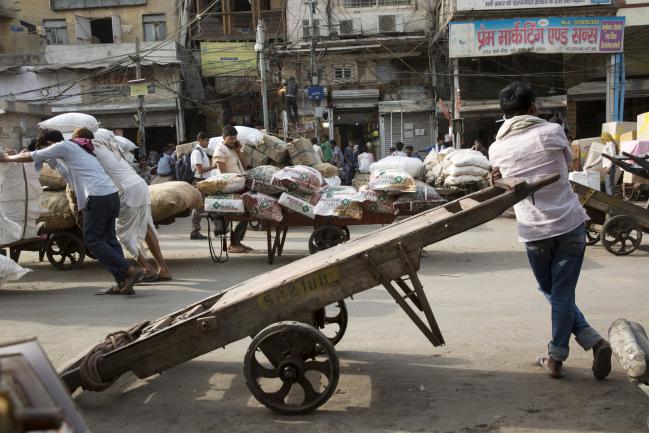 © Bloomberg. A worker leans against a cart as other workers transport goods at Khari Baoli spice market in New Delhi, India, on Wednesday, May 30, 2018. Photographer: Ruhani Kaur/Bloomberg
© Bloomberg. A worker leans against a cart as other workers transport goods at Khari Baoli spice market in New Delhi, India, on Wednesday, May 30, 2018. Photographer: Ruhani Kaur/Bloomberg(Bloomberg) — India’s economic growth is picking up pace in an environment of rising price pressures, setting the stage for an interest rate increase as early as next week.
Growth accelerated to 7.7 percent in the fourth quarter of the financial year ended March 31, government data showed on Thursday, the fastest pace of any major economy. That’s adding to calls for Governor Urjit Patel to pull the rate trigger at the June 6 monetary policy meeting, and follow central banks in emerging markets from Argentina to Indonesia that have stepped up action to stem outflows and curb a rout in their currencies.
“After Indonesia and Philippines adjusted rate upwards, we think India’s central bank is likely to follow suit and begin policy normalization,” said Shashank Mendiratta, an economist with ANZ Banking Group in Bengaluru, who is forecasting a 25 basis-point hike next week. “Inflation will remain above 4 percent through 2018.”
The rupee is the worst performing currency in Asia this year, down more than 5 percent against the dollar, and coupled with surging oil prices, is a major threat to inflation. The Reserve Bank of India aims to keep inflation at 4 percent over the medium term, and it’s already running well above that, at 4.6 percent, with economists in a Bloomberg survey forecasting it could go to more than 5 percent in coming months.
The currency rose 0.2 percent to 67.27 against the dollar as of 9:50 a.m. in Mumbai on Friday.
Pre-Emptive
Growth in Asia’s third-largest economy is rebounding after reaching 6.7 percent in the 2018 fiscal year, the slowest pace since Prime Minister Narendra Modi came to power. The RBI expects growth to hit 7.4 percent in the year to March 2019 amid improved demand, broadly in line with the market consensus.
In the January-March quarter, growth was underpinned by expansion in manufacturing and farming, while the services industry, which contributes more than 50 percent to gross domestic product, grew at a slightly slower pace. Gross fixed capital formation, a measure of private investment, climbed 14.4 percent in the quarter from a year ago, showing signs that the recovery is on a solid footing.
Improving demand and a global sell-off in emerging markets are reasons why some economists are calling on the central bank to act early and tighten policy for the first time in more than four years.
“We have been forecasting the first 25 basis-point increase in August, followed by another in October,” said Pranjul Bhandari, chief India economist at HSBC Holdings Plc (LON:). “However, there are risks that it is bought forward to the June 6 meeting.”
A rate hike may assuage nervous investors who have been pulling money out of Indian assets amid mounting bad loans and rising cases of frauds in the banking system. That leaves the economy vulnerable to a large funding gap on its external accounts, just like in the summer of 2013 when India was roiled by the so-called taper tantrum.
As the world’s third-largest oil importer, India is also taking a knock because of rising crude prices. Every $10 increase pushes up the inflation rate by 30-40 basis points and hurts economic growth by about 15 basis points, according to Nomura Holdings Inc.
“For 2019 we are expecting 7.4 percent growth, with a big caveat that if oil prices remain high for too long, then there will be an impact on growth,” said Devendra Kumar Pant, chief economist at Fitch Ratings Ltd.
(Updates with rupee in fifth paragraph.)
Source: Investing.com




























